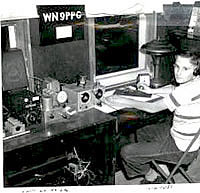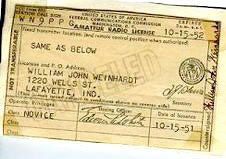|
Bill Weinhardt, W9PPG
Formerly WN9PPG (1951)
 In the spring of 1951, I was 12 years old and had been trying to get ready to take the General Class amateur Radio Examination (Back then it was called Class B). Somewhere at about 10-11wpm, I had met my code stumbling block. Then I learned that during the summer of 1951 a new beginner license was to be issued. To be called the Novice Class license, it was to offer crystal-controlled CW privileges at 75 watts on 80 and 11 meters and phone on a portion of 2 meters. In the spring of 1951, I was 12 years old and had been trying to get ready to take the General Class amateur Radio Examination (Back then it was called Class B). Somewhere at about 10-11wpm, I had met my code stumbling block. Then I learned that during the summer of 1951 a new beginner license was to be issued. To be called the Novice Class license, it was to offer crystal-controlled CW privileges at 75 watts on 80 and 11 meters and phone on a portion of 2 meters.
A friend of my father who was also on Lafayette IN police department thought that I could soon be ready to take the examination so he began giving me extensive help with the code and the written test. Back then there was no question pool giving the exact questions and the exact group of answer choices. The license manual stated a question concept followed usually by a paragraph or two of discussion that encompassed the answer. The license was to be instituted in July of 1951 and I was ready but in those days tests for all classes of Amateur Licenses except class 'C' were administered by an FCC examiner at an FCC examination point. Class 'C' was essentially a Class 'B' license that could be administered by another ham if the applicant lived over a certain distance from an FCC examination point (I think the distance was 150 miles).
At any rate the first time that an FCC examiner was to be at the nearest examination point to Lafayette was to be in August 1951 in Indianapolis IN where they visited quarterly as I recall. As the August date approached Glen, W9ASX worked with me even more intensely increasing the one or two night a week sessions at his house to 3 or four. Finally the date arrived and my mother and father drove me early in the morning the 60 miles to the Post Office in downtown Indianapolis where the examination was to be administered.
I was very nervous as I entered the room with 25-30 others there to take the Novice exam. Soon after the examiner collected the filled out form 610's, the examiner announced that 5 minutes of code was about to be sent at a speed of 5 wpm and to pass, one solid minute's worth would have to be copied with no errors (25 correct characters in a row). At the end of 5 minutes, the papers were collected and graded while applicants waited for results. The examiner announced names of those who passed (about 2/3 of those who took the test) and we lined up to take the code-sending test. I was elated to have passed to this point but was still quite nervous as I set down before the code key to start sending a paragraph on a paper in front of me on the table. After sending a couple of words he said that I had passed and should wait until all remaining were ready to take the written examination.
 I don't remember too much about taking the written examination except that they were not graded at the exam site. When you finished the test you turned it in and left but were told that if you had passed you would receive your license in the mail in several months. I suppose that the FCC probably would notify an applicant they had failed but don't know for sure. I don't remember too much about taking the written examination except that they were not graded at the exam site. When you finished the test you turned it in and left but were told that if you had passed you would receive your license in the mail in several months. I suppose that the FCC probably would notify an applicant they had failed but don't know for sure.
Since I was pretty certain that I had passed the written exam, shortly after returning home, Glen started helping me to assemble a station. He helped me to convert a BC-454 (a WW2 aircraft receiver that covered the 80 meter amateur band) to AC operation by rewiring the tube filaments, building a power supply, installing a volume control, and a switch for a BFO so that it could receive CW. For my transmitter, Glen had an old Meisner 'Signal Shifter' chassis that had been already robbed of some parts for another of his projects. He had me strip the rest of it leaving the power transformer, what other power supply components remained, and the tube sockets. This then became the basis for a 6V6-2E26 crystal-controlled rig for 80-meter CW running about 25 watts input for which Glen had drawn the circuit. The parts needed that weren't among those I had stripped from the chassis came from Glen's 'junk box' and the 2E26 was a pull from the Motorola VHF-FM radios that filled the trunks of the police cars. The 6V6 had been the audio output tube from a defunct broadcast band radio that had been relegated to our basement. My antenna was an 80-meter dipole meter center-fed with open wire line. The open-wire line I made myself using for spacers the plastic curlers from my mom's home permanent stuff.
By the time my license arrived in the mail (WN9PPG) somewhere around my birthday in early October of 1951, I was ready to go. While I made many contacts with the above setup, a new Novice could not rest on their laurels for very long since the Novice license at that time was a 'drop dead' license. If you had not progressed to a higher license class in one year, your license was no longer valid and you were done. If I remember correctly, you could not even take the exam again for a new Novice license. So I soon started working with Glen on the Class 'B' license (soon to be called General class). Operating on the 80 meter Novice band helped me get my code speed up to the 13-wpm and with Glen's help I mastered the theory. In May of 1952, Dad and I took the train to Chicago and I made an appearance at the FCC office in the old Federal Office Building. I was certain I had failed the code test but after papers were graded was told to sit down and start sending. Then on to the written test. Back then one had to draw schematics for answers to some of the questions. After completing the test and turning in my papers I was unsure if I had passed or not but in July of 1952 an envelope came in the mail and I now had a new license with the 'N' no longer in my call sign
.Amateur Radio has been a great hobby for me over the past 56 years and was probably responsible for me becoming an electrical engineer and also was probably in part responsible for me becoming a Naval Officer. After my stint in the Navy it has influenced my engineering career in many ways and helped provide the impetus to obtain a 1st Class RadioTelephone License and later become licensed as a Professional Engineer. Though there have been periods in my life where I wasn't very active such as in college or on a submarine in the Pacific where COMSUBPAC didn't permit amateur operation on his boats, Amateur Radio is always something that I came back to.
Bill Weinhardt, W9PPG |